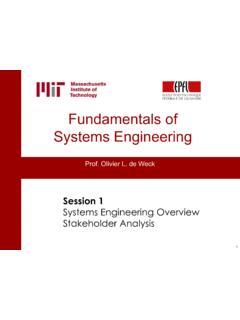Transcription of Introduction to Augmented Reality - LNCC
1 Introduction to Augmented RealityR. Silva, J. C. Oliveira, G. A. GiraldiNational Laboratory for Scientific Computation,Av. Getulio Vargas, 333 - Quitandinha - paper presents an overview of basic aspects of Augmented Reality (AR) and the mainconcepts of this technology. It describes the main fields in which AR is applied nowadaysand important AR devices. Some characteristics of Augmented Reality systems will bediscussed and this paper will provide an overview of them. Future directions are : Augmented Reality , Virtual Reality , Scientific Visualization1 INTRODUCTIONA ugmented Reality (AR) is a new technologythat involves the overlay of computer graph-ics on the real world (Figure 1). One of thebest overviews of the technology is [4], thatdefined the field, described many problems,and summarized the developments up to thatpoint.
2 That paper provides a starting pointfor anyone interested in researching or usingAugmented is within a more general context termedMixed Reality (MR) [20], which refers toa multi-axis spectrum of areas that coverVirtual Reality (VR), AR, telepresence, andother related Reality is a term used for computer-generated 3D environments that allow theuser to enter and interact with synthetic en-vironments [9][27][28]. The users are able to immerse themselves to varying degrees inthe computers artificial world which may ei-ther be a simulation of some form of real-ity [10] or the simulation of a complex phe-nomenon [33][9].Figure 1: AR example with virtualchairs and a virtual telepresence, the fundamental purpose isto extend operator s sensory-motor facilitiesand problem solving abilities to a remote en-vironment.
3 In this sense, telepresence can bedefined as a human/machine system in whichthe human operator receives sufficient infor-mation about the teleoperator and the taskenvironment, displayed in a sufficiently nat-ural way, that the operator feels physicallypresent at the remote site [26]. Very similarto virtual Reality , in which we aim to achievethe illusion of presence within a computersimulation, telepresence aims to achieve theillusion of presence at a remote can be considered a tecnology between1VR and telepresence. While in VR the envi-ronment is completely synthetic and in telep-resence it is completely real, in AR the usersees the real worldaugmentedwith designing an AR system, three aspectsmust be in mind: (1) Combination of real andvirtual worlds; (2) Interactivity in real time;(3) Registration in devices, like Head-Mounted-Displays (HMD) [28], could be used to showthe Augmented scene, but other technologiesare also available [4].
4 Besides the mentioned three aspects, anotherone could be incorporated: Portability. Inalmost all virtual environment systems, theuser is not allowed to go around much due todevices limitations. However, some AR ap-plications will need that the user really walksthrough a large environment. Thus, portabil-ity becomes an important such applications, the 3 Dregistration be-comes even more complex. Wearable com-puting applications generally provide unreg-istered, text/graphics information using amonocular HMD. These systems are moreof a see-around setup and not an Aug-mented Reality system by the narrow defini-tion. Henceforth, computing platforms andwearable display devices used in AR must beoften developed for more general applications(see section 3).
5 The field of Augmented Reality has existedfor just over one decade, but the growth andprogress in the past few years has been re-markable [12]. Since [4], the field has grownrapidly. Several conferences specialized inthis area were started, including the Inter-national Workshop and Symposium on Aug-mented Reality , the International Sympo-sium on Mixed Reality , and the DesigningAugmented Reality Environments AR Scene GeneratorThe scene generator is the device or softwareresponsible for rendering the scene. Render-ing is not currently one of the major problemsin AR, because a few virtual objects need tobe drawn, and they often do not necessarilyhave to be realistically rendered in order toserve the purposes of the application [4].
6 Tracking SystemThe tracking system is one of the most impor-tant problems on AR systems mostly becauseof the registration problem [3]. The objectsin the real and virtual worlds must be prop-erly aligned with respect to each other, orthe illusion that the two worlds coexist willbe compromised. For the industry, many ap-plications demand accurate registration, spe-cially on medical systems [16][4]. DisplayThe tecnology for AR is still in developmentand solutions depend on design of the Displays devices for AR are HMD(Head Mounted Display), but other solutionscan be found (see section 3).When combining the real and virtual worldtwo basic choices are available: optical andvideo technology. Each of them has sometradeoffs depending on factors like resolution,flexibility, field-of-view, registration strate-gies, among others [4].
7 Display technology continues to be a limit-ing factor in the development of AR are still no see-through displays thathave sufficient brightness, resolution, field ofview, and contrast to seamlessly blend a widerange of real and virtual imagery. Further-more, many technologies that begin to ap-proach these goals are not yet sufficientlysmall, lightweight, and low-cost. Neverthe-less, the past few years have seen a numberof advances in see-through display technol-ogy, as we shall see AR DevicesFour major classes of AR can be distin-guished by their display type: Optical See-Through, Virtual Retinal Systems, VideoSee-Through, Monitor Based AR and Pro-jector Based following sections show the correspond-ing devices and present their main Optical See-Through HMDO ptical See-Through AR uses a transparentHead Mounted Display to show the virtualenvironment directly over the real world (Fig-ures 2 and 3).
8 It works by placing opticalcombiners in front of the user s eyes. Thesecombiners are partially transmissive, so thatthe user can look directly through them tosee the real world. The combiners are alsopartially reflective, so that the user sees vir-tual images bounced off the combiners fromhead-mounted examples of an Optical See-throughAR system are the various Augmented medi-cal systems. The MIT Image Guided Surgeryhas concentrated on brain surgery [15]. UNChas been working with an AR enhanced ultra-sound system and other ways to superimposeradiographic images on a patient [23]. Thereare many other Optical See-through systems,as it seems to be the main direction for of these specific examples, there isstill a lack of general purpose see-throughHMDs.
9 One issue for Optical See-throughAR is the alignment of the HMD optics withthe real world. A good HMD allows adjust-ments to fit the eye position and comfort ofindividual users. It should also be easy tomove it out of the way when not , these movements will alter the reg-istration of the VE over the real world andrequire re-calibration of the system. An ex-pensive solution would be to instrument theadjustments, so the system couldautomagi-callycompensate for the motion. Such de-vices are not reported in the 2: Optical See-Through 3: Optical See-Through Optical See-Through HMD s are be-ing built for well-known companies like Sonyand Olympus and have support for occlusion,varying accommodation (process of focusingthe eyes on objects at a particular distance).
10 There are very small prototypes that can beattached to conventional eyeglasses (Figure4).Figure 4: Eyeglass display with holo-graphic Virtual Retinal SystemsThe VRD (Virtual Retinal Display) was in-vented at the University of Washington inthe Human Interface Technology Lab (HIT)in 1991. The aim was to produce a fullcolor, wide field-of-view, high resolution, highbrightness, low cost virtual display. Microvi-sion Inc. has the exclusive license to com-mercialize the VRD technology (Figure 5).3 This technology has many potential applica-tions, from head-mounted displays (HMDs)for military/ aerospace applications to medi-cal VRD projects a modulated beam of light(from an electronic source) directly onto theretina of the eye producing a rasterized im-age (Figure 6).









